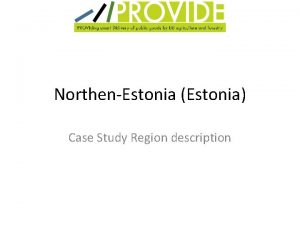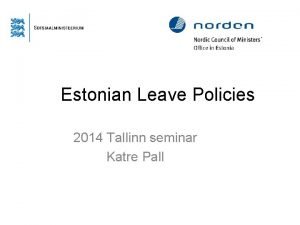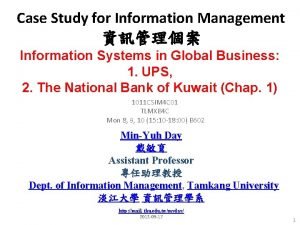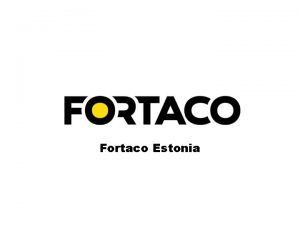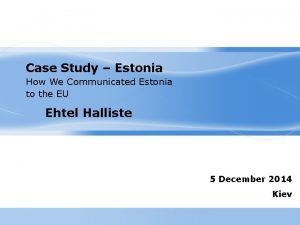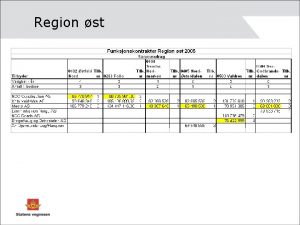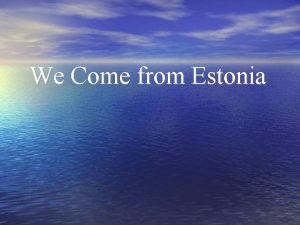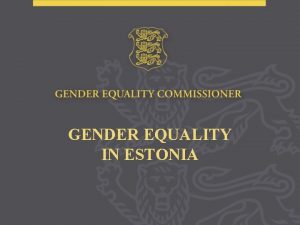NorthenEstonia Estonia Case Study Region description General information









- Slides: 9

Northen-Estonia (Estonia) Case Study Region description

General information • Location: +

General information • Population: 634 663 inhabitants, incl. : _Harju county: 575 600; Lääne-Viru county: 59 063 • Density of population (inhabitants per km 2): _ Harju county: 132, 8; Lääne-Viru county: 16, 3 • Area: Harju: 4333 km 2; Lääne-Viru: 3627 km 2 GDP per capita • Economy: 2013 Harju county 20 151€ Lääne-Viru county 10 411€ Regional average 15 280€ GDP composition 2013 Primary Secondary Tertiary Harju county 1% 24% 75% Lääne-Viru county 11% 48%

General information

Agriculture Source: Agricultural census, 2012 Use of utilised agricultural area 2010 (ha) Arable land Harju + Lääne-Viru 121330 Fruit and berries Nurseries Permanent grasslands Kitchen gardens 153 150 47772 182

Forestry Forest coverage: about average Harju: more than average 51%, Lääne-Viru: less than average (48%). 2013 State forest (ha) Municipal forest (ha) Private forest (ha) Harju 108 499 756 88 425 Lääne-Viru 93 455 358 79 084 Source: Yearbook Forest 2013; Estonian Land Board 2014 Number of woodland key habitats (WKH) Average WKH area (ha) Nature protection area, mainland (ha) Landscape protection area, mainland (ha) National park (No) Harju 411 1, 7 24 609 16 945 1 Lääne-Viru 433 2, 2 11 287 9 971 - Source: Yearbook Forest 2013; Estonian Nature Information System, Estonian Environment Agency

Main issues relevant for the project (Ag & For. ) • The overal situation with public goods like fresh air, quality of water, biological diversity is good (e. g. Estonia is the 1 st in Europe concerning the richness per km 2; quite large wolf and bear population); • We still have to specify the concrete borders of the case area in Estonia (not to follow the administrative territorial division, but instead for instance landscape zones: coastal area, Harju plateau, etc. )

First stakeholder interview: Representative of the Estonian Fund for Nature • How would you define a public good in the context of agriculture and forestry? Public good is opposite to private good, meaning that more than one person, even a lot of people should benefit of it. In the context of agriculture and forestry it could be defined through the clean environment and environment friendly sustainable management of forests and agricultural land. • What are the main public goods in the region? – From agriculture? Scenery, local food? ? – From forestry? Recreation, nature tourism, hunting, food gathering (berries, mushrooms) – From the landscape as a whole? Recreation and tourism mainly: A northern coastal areas of Estonia (towards Finnish gulf); the waterfalls; bogs • What are the main public bads in the region? – From agriculture: pollution of water (rivers) because of fertilizing and drainage repairing – From forestry: clear-cut of forests is visually disturbing; pollution of rivers because of drainage – From the landscape as a whole? Barrages on the rivers hinder fish migration and also recreational activities on water Public bads relate more to agriculture. Are the public goods in the region a direct result of land management or are they unintended by-products? And the bads? Mostly unintended by products, but the recreational possibilities at state forest areas are directly intended to serve this kind of public good. •

First stakeholder interview: Representative of the Estonian Fund for Nature • Where are the public goods located in your region? And the bads? It depends on the public good and bad . • Are the public goods connected to specific elements of the landscape? E. g. Forests, bogs, rivers with waterfalls, the coast. And the bads? E. g. Clear-cut areas, „port buildings“ on the coasts • What are the main issues with regard to public goods/bads? – On the supply side? On agricultural side its more of the competition or conflict between profit VS fertilisers; on coastal areas and forests its more related to ownership structures – also private land should let you walk along the coast and through the forest (at daytime); – On the demand side? Probably access issues – you can’t hike through places that you should have access or access to some area is cut off + too little strategic and long-term thinking; inter-generational public good!? • What are the main motivations to manage the land for the provision of public goods for private land owners? E. g. private land owner could be interested to make the route through his/her land, if some public body would take care of the maintance of this route. • What mechanisms could be used to improve the provision of public goods? And to reduce public bads? Usually the combination of different mechanisms (regulative, economic, informational, instrumental) have better effects + also case specific solutions
 Estonia case study
Estonia case study Katre pall
Katre pall Best worst and average case
Best worst and average case It project failure case study
It project failure case study Laudon and laudon 2012
Laudon and laudon 2012 Management information system case study
Management information system case study Management information system case study with solution
Management information system case study with solution Information system in e commerce case study
Information system in e commerce case study Ethical and social issues in information systems doc
Ethical and social issues in information systems doc Management information system case study banking
Management information system case study banking
